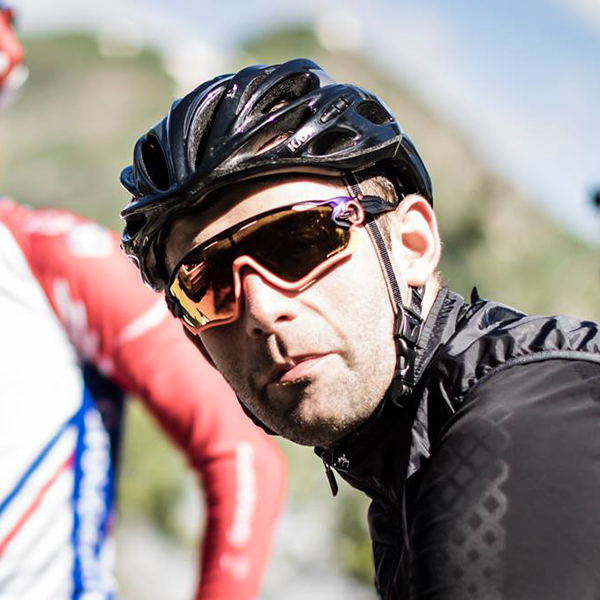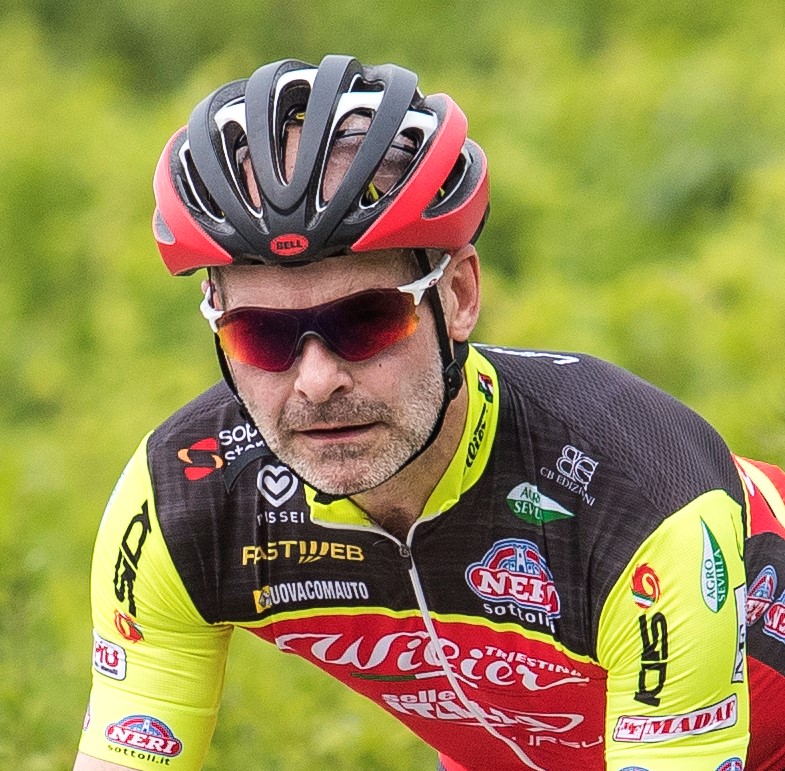A set of the best bike lights will help you be seen when cycling at night, when visibility is poor and in bad weather.
We have tested more than 500 bike lights and bike light sets over the past 17 years, assessing the lights in various real-world conditions and considering factors such as beam pattern, battery life, practicality and value for money.
Following our latest group test, we’ve compiled our top picks of the best bike lights below, splitting them into front and rear lights. Below that, you can read our buyer’s guide explaining all you need to know when shopping for the best bike lights.
Editor's note: we updated our best bike lights list on 6 October 2025, adding our high-scoring Exposure Sirius MK10 Daybright and Ravemen TR250 reviews. We have also removed older entries from the list.
Best bike lights at a glance
SQUIRREL_PLAYLIST_10105774
Best overall front light: Knog Blinder 1300

The Knog Blinder 1300 is a powerful, versatile front bike light with six modes, great beam spread, and long battery life for both road and trail use.
- Read more: Knog Blinder 1300 review
SQUIRREL_TEXT_13115237
Best overall rear light: Lezyne Strip Drive Pro 400+

Lezyne’s updated Strip Drive offers up to 400 lumens, improved optics and seven modes. Battery life ranges from 5.5 to 80 hours. It features mode memory and easy operation, and balances high power with efficiency for versatile use.
- Read more: Lezyne Strip Drive Pro 400+ review
SQUIRREL_TEXT_13083492
Best in class front light: Magicshine Ray 2600B Smart Remote

The Magicshine Ray 2600B is a powerful, tech-packed bike light with auto-dimming, a dual-beam pattern and a handlebar remote. Ideal for gravel tracks, it offers customisable modes via its app, all at a competitive price.
- Read more: Magicshine Ray 2600B Smart Remote review
SQUIRREL_TEXT_13111576
Best in class rear light: Exposure Blaze Mk3 Reakt + Peloton

The Exposure Blaze Mk3 Reakt + Peloton features a premium build, focused beam and three output levels with static or pulse modes. Reakt mode boosts brightness when braking or in daylight, while Peloton mode dims to avoid dazzling riders behind you.
SQUIRREL_TEXT_13122131
Best budget front light: NiteRider Swift 500

This budget-friendly commuter light is bright enough for city use, simple and durable. It features a fixed rubber strap, Micro-USB charging and a daytime mode, making it a practical choice for staying visible on urban roads.
- Read more: NiteRider Swift 500 review
SQUIRREL_TEXT_13084635
Best budget rear light: Sigma Buster RL 150

The Sigma Buster RL 150 is a compact rear light with two solid and three flashing modes, a flexible silicone mount and an accelerator sensor that boosts brightness when slowing. It meets its claimed four-hour runtime, though dims slightly after three.
- Read more: Sigma Buster RL 150 review
SQUIRREL_TEXT_13083259
Navigation
- Best front bike lights
- Best rear bike lights
- How we test bike lights
- Why you can trust BikeRadar
- Buyer’s guide to bike lights
Best bike lights in detail
Best front bike lights
Knog Blinder 1300 – best overall front light
SQUIRREL_TEXT_13115237

- £100 / $100 / €100 / AU$170 as tested
- Pros: Small profile on the handlebar; quality feel; GoPro mount included
- Cons: Sharp edges; fairly short peak runtime
The Knog Blinder 1300 is the best overall front bike light on our list and is useful for on- and off-road riding.
Despite the nominally low 1,300-lumen output, the Blinder didn’t feel unpowered, with a powerful central beam and peripheral illumination.
The front light has six modes operated by a single button. The claimed runtimes range from 1hr 30 min at its maximum solid output (though on test that was closer to 2hrs) to 120hrs for eco flash.
- Read more: Knog Blinder 1300 review
Specs
Max lumens: 1,300 | Runtime (max output): 2hrs | Modes: 6 | Weight: 162g
SQUIRREL_13115237
Lezyne Macro Drive 1400+
SQUIRREL_TEXT_13083258
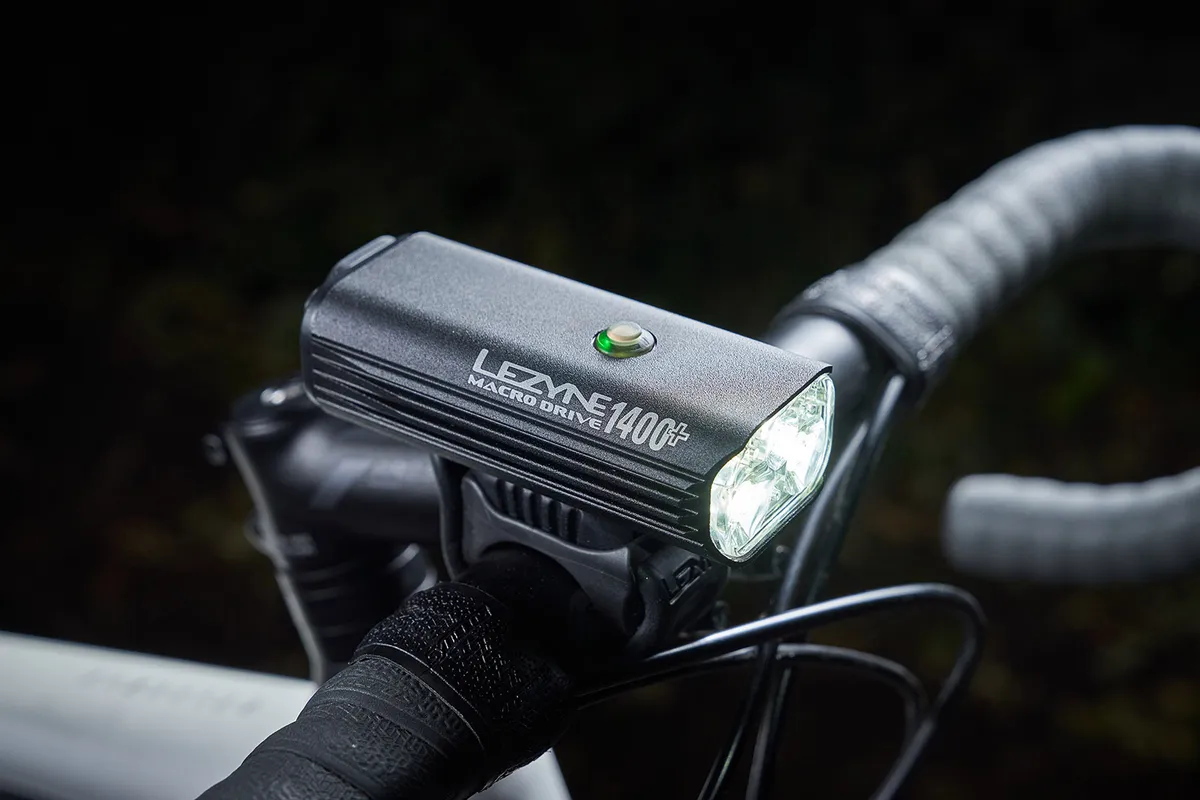
- £100 / $100 / €100 as tested
- Pros: High output for a long time; robust build
- Cons: Few functions compared to competitors
The Lezyne Macro Drive 1400+ offers long runtimes in a compact, robust build.
The light beam has a central focus illuminating roads well, and the peripheral illumination helps you see what’s at the edge of your vision.
It charges with a USB-C port and while it’s not as feature-rich as some competitors, it packs a powerful punch.
- Read more: Lezyne Macro Drive 1400+ review
Specs
Max lumens: 1,400 | Runtime (max power): 3hrs | Modes: 7 | Weight: 230g
SQUIRREL_13083258
Magicshine Ray 2600B Smart Remote – best in class front light
SQUIRREL_TEXT_13111576

- $159 as tested
- Pros: Good runtime; bright enough for trails; handlebar remote
- Cons: Glitchy app; no mode indicator
The Magicshine Ray 2600B Smart Remote Bike Light is powerful, with auto-dimming tech and a dual-beam pattern forming a great light for night riding at a competitive price.
It could be considered a gravel bike light, with enough power to illuminate gravel tracks.
The light packs in a lot of tech. You can pair it with a slightly glitchy app to unlock various features and customise the modes. There is also a remote control you can mount to your handlebar for quick changes to brightness.
- Read more: Magicshine Ray 2600B Smart Remote review
Specs
Max lumens: 2,600 | Runtime (max power): 1hr 15min | Modes: 3 default | Weight: 192g
SQUIRREL_13111576
Bookman Volume 1500
SQUIRREL_TEXT_13122124

- £130 / $149 / €149 as tested
- Pros: Controls are easy to use; runtime
- Cons: No powered-down mode; price
The Volume 1500 is Bookman’s highest-output light. It offers well-thought-out features, a broad spread of light and a reasonable battery life.
It has an on/off button on the top paired with a rotary dial on the side to switch between its modes, which is easier to use than most button controls.
The Volume 1500’s waterproof rating is slightly lower than competitors – possibly because of the rotary dial – and it's pricier and heavier than other lights. But it’s still an appealing option thanks to its ease of use and clean aesthetics.
- Read more: Bookman Volume 1500 review
Specs
Max lumens: 1500 | Runtime (max power): 2hrs 30min | Modes: 10 | Weight: 202g
SQUIRREL_13122124
Exposure Sirius Mk10 Daybright
SQUIRREL_TEXT_13330850

- £95 / $105 / €95 as tested
- Pros: Impressive quality; compact; good beam pattern and output
- Cons: Mode selection could be easier; long charge time with proprietary USB cable
Exposure's Sirius MK 10 Daybright has a premium feel thanks to a superb build quality and strong performance on the bike.
The light is designed as a 'to be seen' light, but its output and beam pattern make it usable for road navigation past nightfall.
It is expensive, and we felt the mode selection was a little tricky. It also takes a while to charge and requires a proprietary USB cable.
- Read more: Exposure Sirius Mk10 Daybright review
Specs
Max lumens: 950 | Runtime (max power): 1hr 30min | Modes: 7 | Weight: 86g
SQUIRREL_13330850
Magicshine Allty 1500S
SQUIRREL_TEXT_13120683

- £90 / $110 / €102 / AU$170 as tested
- Pros: Compact, swappable battery; Garmin-mount compatible
- Cons: Helmet mount not included; heavy for helmet use
The Magicshine Allty 1500S is billed as a light for urban riding, but it would be well-suited to unlit roads too. Its high output, reasonable runtime and swappable battery make it a useful and versatile option.
The light comes with some handy accessories, including a remote that you can mount to your handlebar.
Unfortunately, a helmet mount isn't included, although you may find the light to be too heavy when mounted on your lid. This is a shame because the point-focused beam is arguably more suitable for use on a helmet, with a lack of peripheral illumination.
- Read more: Magicshine Allty 1500S review
Specs
Max lumens: 1,500 | Runtime (max power): 2hrs | Modes: 6 | Weight: 172g
SQUIRREL_13120683
Moon Rigel Max
SQUIRREL_TEXT_13122126

- £80 / $85 / AU$100 as tested
- Pros: Easy to switch between constant modes; helmet mount included
- Cons: Heavy for helmet use; fairly short peak runtime
The Moon Rigel Max is a compact front light that feels well built, with its metal case, USB-C charging and single control button.
You can switch easily between the two constant modes to avoid dazzling road users, while a double tap of the light’s button switches you to four flashing modes.
Moon provides three mounting options: a top-bar mount, a GoPro under-bar mount and a helmet strap. However, it’s on the heavy side for use on your helmet.
- Read more: Moon Rigel Max review
Specs
Max lumens: 1,500 | Runtime (max power): 1hr 40min | Modes: 6 | Weight: 150g
SQUIRREL_13122126
NiteRider Swift 500 – best cheap front light
SQUIRREL_TEXT_13084635

- £25 / $40 / AU$49 as tested
- Pros: Easy to use; hardy waterproof construction
- Cons: Not enough light spill on either side; runtime not as accurate as claimed
This budget commuter light is cheap, robust and simple to use, while keeping you seen out on the roads. It's bright enough for use in the city and the rubber strap is permanently affixed to the light's base.
The light charges via Micro-USB and there's even a daytime mode.
- Read more: NiteRider Swift 500 review
Specs
Max lumens: 500 | Runtime (max power): 1hr 30min | Modes: 5 | Weight: 83g
SQUIRREL_13084635
Best rear bike lights
Lezyne Strip Drive Pro 400+ – best overall rear light
SQUIRREL_TEXT_13083492

- £55 / $55 as tested
- Pros: Power and visibility; seven modes; easy operation
- Cons: Charging cable not included
Lezyne's latest update to the Strip Drive sees a flashing output of up to 400 lumens, a longer battery life and improved optics. Seven modes include two always-on, a pulse and four flashing options. Claimed battery life is between 5.5 and 80 hours.
A long press turns the light on and subsequent presses cycle through the seven modes. A memory function saves you some work the next time you switch the light on. It's powerful when needed and frugal too.
- Read more: Lezyne Strip Drive Pro 400+ review
Specs
Max lumens: 400 | Runtime (claimed): 5.5hrs | Modes: 7 | Weight: 79g
SQUIRREL_13083492
Cateye Viz450
SQUIRREL_TEXT_13085006
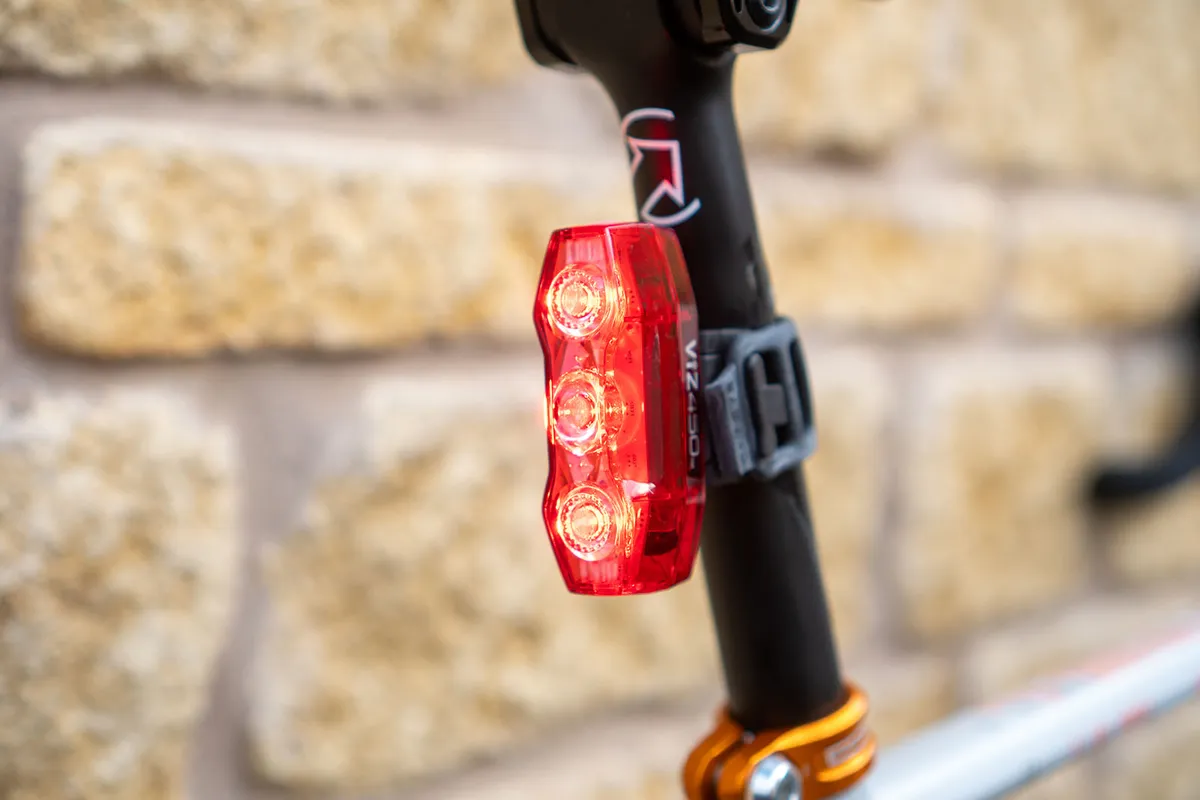
- £50 / $50 as tested
- Pros: Simple to use; HyperFlash mode
- Cons: Battery life; still uses micro-USB
Cateye's Viz450 packs a punch in a compact unit. There are four modes to choose from, with the 'HyperFlash' option activating all five of the light's LEDs, delivering 450-lumen bursts.
This feature worked well in day and night settings, certainly grabbing road users' attention, but it might not be the most pleasant experience for a driver behind you in an urban setting.
You can mount the light horizontally or vertically, which is perfect if you don't have a lot of seatpost real estate.
- Read more: Cateye Viz450 review
Specs
Max lumens: 450 | Runtime: 5hrs (40-lumen) | Modes: 4 | Weight: 72g
SQUIRREL_13085006
Exposure Blaze Mk3 Reakt + Peloton – best in class rear light
SQUIRREL_TEXT_13122131

- £130 / $143 / €130 as tested
- Pros: Focused light; premium construction
- Cons: Proprietary charging port
The Exposure Blaze Mk3 Reakt + Peloton impresses with a focused spot of light and premium construction.
The three standard programs offer high, medium and low outputs. Once you’ve selected the level that suits your needs, you can then toggle between a static and ‘pulse’ flash mode.
On top of this, the Reakt mode combines a brake and ambient light sensor. Slow down and it will switch to 150 lumens, or move into brighter light and the Blaze will brighten its output. Peloton mode dims the light when it senses a light behind to avoid dazzling other riders.
Specs
Max lumens: 150 | Runtime: up to 48hrs | Weight: 91g
SQUIRREL_13122131
Knog Blinder Road Rear 150
SQUIRREL_TEXT_13092588
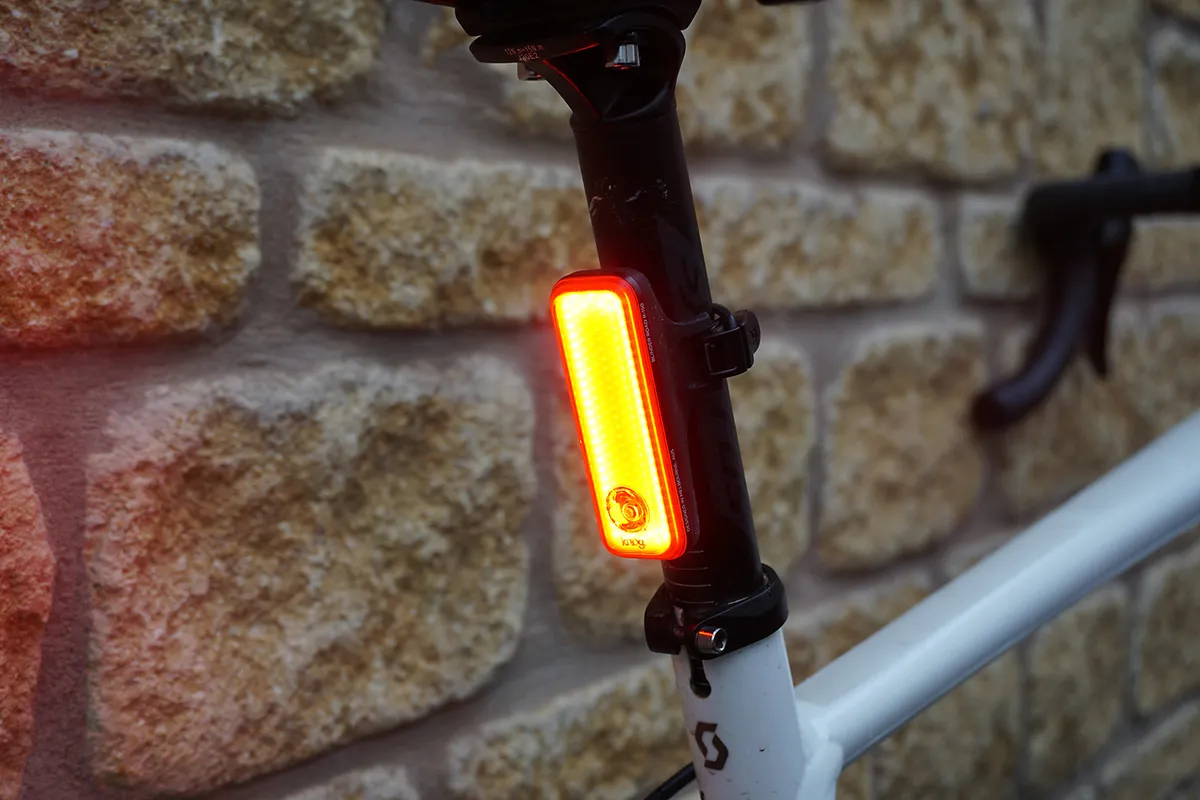
- £63 / $65 / €65 / AU$100 as tested
- Pros: High output; nine modes
- Cons: Exposed USB
The Knog Blinder has a large illuminated surface thanks to an array of COB LEDs plus a single larger strobe LED. There are nine modes to choose from, with runtimes between 2.5 hours and 50 hours.
Fortunately, there's a memory function, so the light turns on with your preferred illumination pattern.
The design includes an exposed USB connector. We'd have felt happier if this was covered to avoid potential corrosion. Otherwise, it's a quality package with plenty of light output.
- Read more: Knog Blinder Road Rear 150 review
Specs
Max lumens: 150 | Runtime (claimed): 50hrs | Modes: 9 | Weight: 43g
SQUIRREL_13092588
Lezyne Strip Drive Pro Alert 300
SQUIRREL_TEXT_13095586
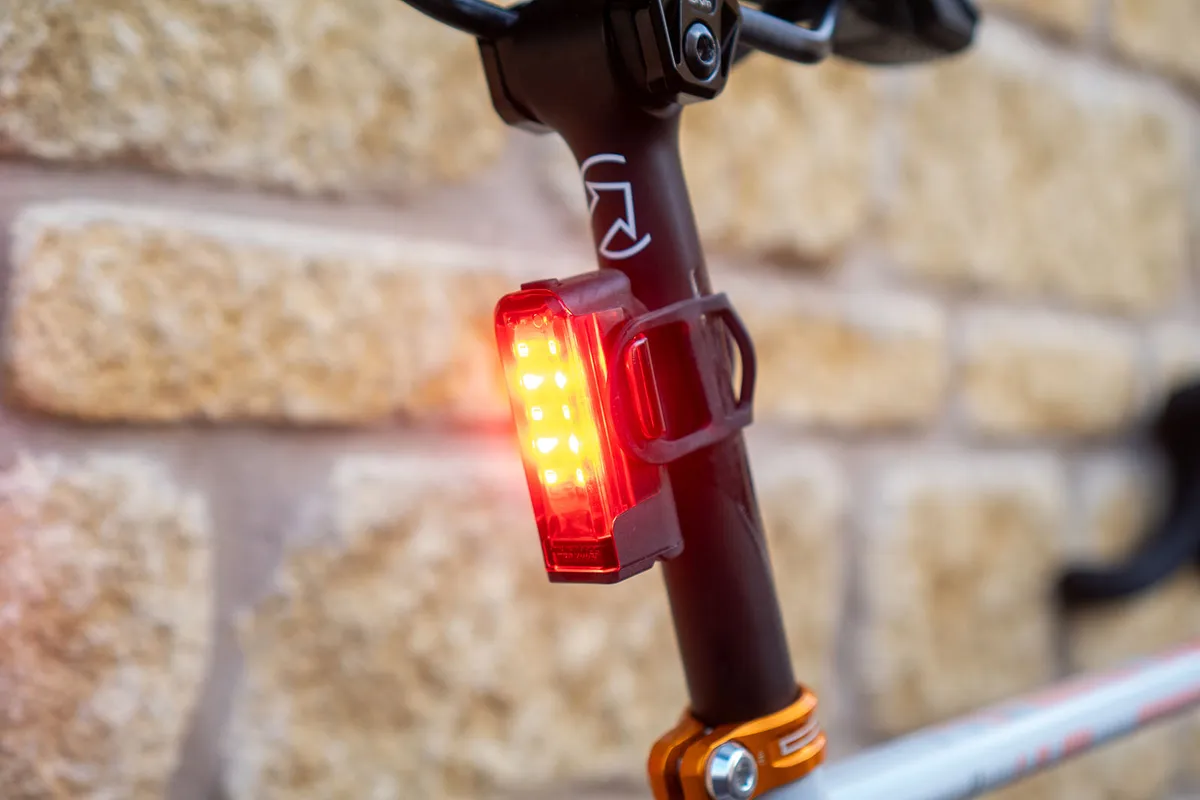
- £57 / $60 / AU$97 as tested
- Pros: Bright; braking alert mode; simple mount
- Cons: Fluctuating battery life
Top of Lezyne's six-model Strip Drive range, the Alert 300 packs in a shockingly bright 300 lumens. The Alert function uses an accelerometer to up the light's brightness when you slow down and the lens pattern gives 270-degree visibility.
There are five modes, including two constant and three flashing options. Runtimes are good, but Alert (which can't be switched off) results in variable battery life, which can be appreciably lower in stop-start traffic than on a steady ride.
- Read more: Lezyne Strip Drive Pro Alert 300 review
Specs
Max lumens: 300 | Runtime (max power): 6hrs (35 lumens) | Modes: 5 | Weight: 65g
SQUIRREL_13095586
Moon Helix Sense 450
SQUIRREL_TEXT_13122132

- £59.99 / $69.90 as tested
- Pros: Brake light function
- Cons: Features can be baffling
The Moon Helix Sense 450 has a wealth of features that can be baffling. But once you’ve found your preferred settings, it’s an excellent taillight.
It is almost identical to the Helix Max, in terms of features and looks, but it has an additional brake-sensing function and an increased power output of 450 lumens.
In daylight, the light switches automatically into its brightest daytime flash mode. When dark, it operates in your chosen setting. The brake function is always on and temporarily makes the light shine statically before returning to the chosen mode.
Specs
Max lumens: 450 | Run time: up to 10hrs | Modes: 5 | Weight: 54g
SQUIRREL_13122132
Oxford UltraTorch R75
SQUIRREL_TEXT_13190785
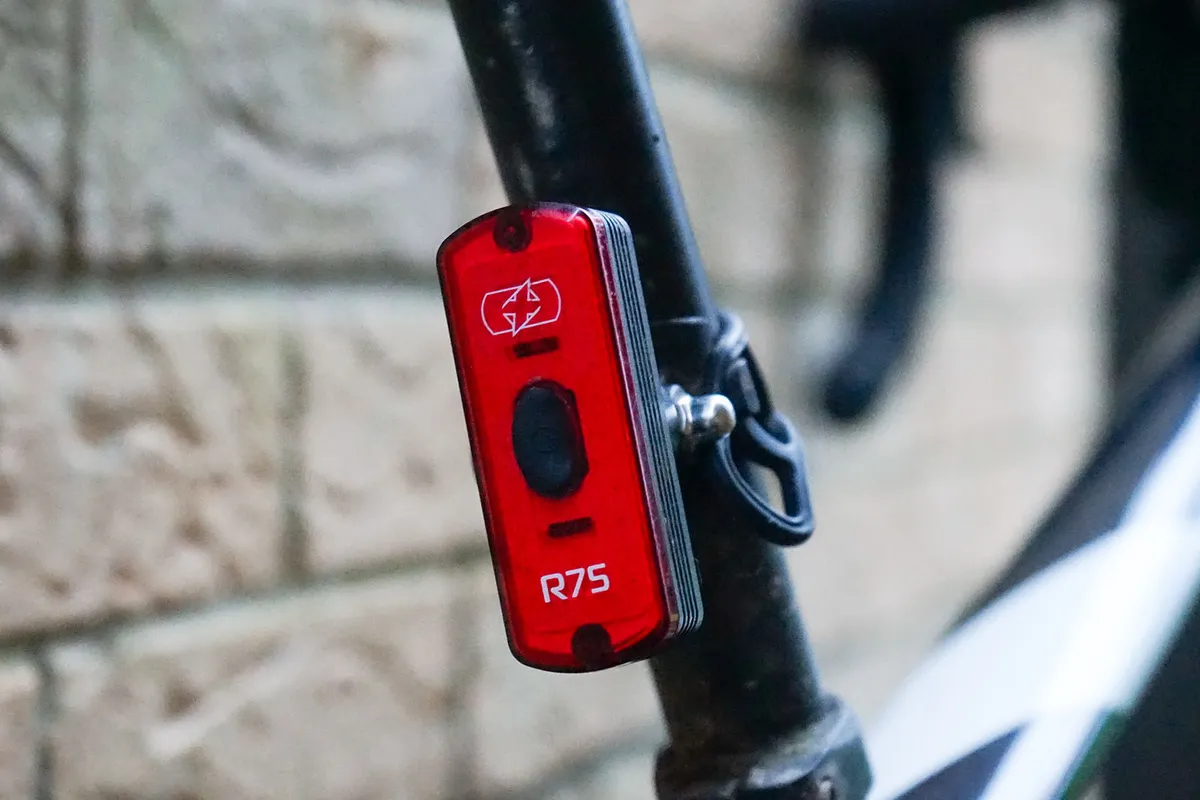
- £30 as tested
- Pros: Lightweight; long runtime
- Cons: No daytime mode; gets hot in full-beam mode
The Oxford UltraTorch R75 rear light is a fantastically capable performer, especially when you consider its £30 price tag.
The rear light has a long runtime and is impressively bright. The shape of the light means its beam spills out from the sides, which will prove particularly valuable if you're commuting through busy city streets.
- Read more: Oxford UltraTorch R75 review
Specs
Max lumens: 75 | Runtime (max power): 2hrs 15min | Modes: 4 | Weight: 50g
SQUIRREL_13190785
Ravemen TR250
SQUIRREL_TEXT_13383904

- £49.99 / $39.95 / €39.95 as tested
- Pros: Brake function; auto-on; three mounting options
- Cons: Unpredictable runtimes
The Ravemen TR250 replaces the TR200 with a brighter 250-lumen output and refined features.
However, on paper, battery life has dropped from 26 to 18.5 hours, due to revised runtime estimates and the brighter output.
The brake function is highly responsive, only activating with significant deceleration, and the three-second bright flash improves visibility.
The auto-on feature is now less sensitive, reducing the likelihood of accidental activation.
It includes three secure mounting options, with angle adjustment on the seatpost mount.
A USB-A to USB-C cable is provided, and despite the performance upgrade, Ravemen has maintained the same price, offering good value for money.
Max lumens: 250 | Runtime: Up to 18.5hrs | Modes: 6 | Weight: 68g
SQUIRREL_13383904
Sigma Buster RL 150 – best budget rear light
SQUIRREL_TEXT_13083259

- £30 as tested
- Pros: Easy to use; small; brake light feature
- Cons: Not the most powerful
Sigma's Buster RL 150 is a compact unit and mounts via a simple, flexible silicone mount. There are two solid and three flashing modes.
A built-in accelerator mode detects when you are slowing down and increases the brightness of the light.
The light lives up to its four-hour claimed runtime, although our tester found it defaulted to a lower-lumen mode after three hours.
- Read more: Sigma Buster RL 150 review
Specs
Max lumens: 150 | Runtime (max power): 4hrs | Modes: 5 | Weight: 38g
SQUIRREL_13083259
How we test bike lights

We spend hours cycling in the dark to test the real-world performance of bike lights. We assess their beam power, the bike light brackets, battery life, charge time and general user experience.
We always consider value for money when reaching their verdicts – sometimes the cheapest light isn’t the best value, while the most feature-packed or powerful might not be the best overall.
Any bike light in this list is worth considering and many options will suit your specific needs.
When choosing our top recommendations, though, the decision comes down to our overall impression of the light’s performance, functionality, ease of use and value. Only the standout candidates are selected.
Of course, if you have specific needs or features that you prioritise, you can find those in the pros and cons lists, as well as click through to read our full in-depth reviews.
We keep this list updated as and when we test new lights that score highly enough, and remove old lights once they stop being widely available to buy from retailers.
Why you can trust BikeRadar

BikeRadar has been an authority on bikes and cycling tech since its inception in 2007, delivering the world’s best riding advice.
We have experts testing all types of bikes, parts, clothing and accessories, from road, mountain and gravel bikes to commuting, bikepacking and electric bikes.
Our reviews are always editorially independent – with no exceptions. Our reviewers comprehensively test all products in the real world, always reflecting on performance, value and the wider market when delivering their verdicts and review ratings.
We have more than 15,000 product reviews available at your fingertips, as well as expert buying, maintenance, training, skills, health and fitness advice.
Our annual Bike of the Year test is an industry benchmark and the BikeRadar team consists of some of the most experienced riders and testers in the business.
Buyer’s guide to bike lights

What should you look for in a bike light?
Regardless of whether you’re looking to buy a specialist bike light or a set of lights for commuting, there are five main things to consider when buying cycling lights:
- The brightness of a bike light is important for visibility and to help you see the road ahead, especially on unlit roads. Virtually all modern bike lights use LEDs, which can be extremely bright.
- Beam pattern can make a huge difference to you being seen and seeing, with some less powerful lights outperforming brighter lights in the real world.
- Decent battery life will provide peace of mind while out cycling. There is little point in having a powerful light if it loses power after a short while.
- How a bike light mounts can determine its best use. Fixed mounts will hold a light securely in place, but strap mounts mean you can easily remove the light when locking your bike up.
- Waterproofing is important if you regularly ride in poor weather conditions. A bike light’s IP Code will tell you how waterproof it is. IP4 protects against splashing of water, while an IP7 product will survive immersion in water for 30 minutes.
How bright should bike lights be?
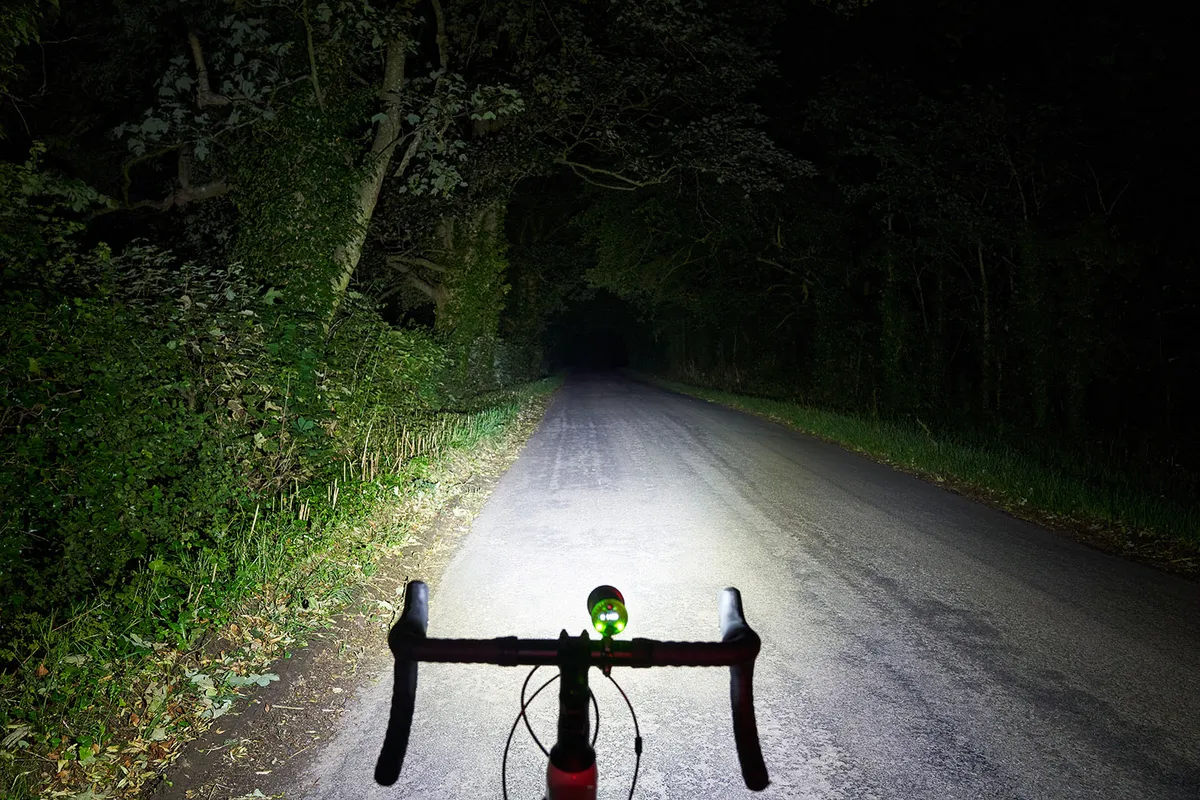
The best bicycle lights use LEDs and can be extremely bright, with some front lights capable of emitting over 2,000 lumens and rear lights over 300 lumens. For context, a 100W incandescent lightbulb emits roughly 1,600 lumens.
The reality is it’s unlikely you need your bike light to be this bright.
A front bike light with 200 lumens should be sufficient to be seen on lit urban roads, but 300 lumens will illuminate some of the roads in front of you.
We suggest a front light with a minimum of 600 lumens for riding on unlit roads, but one with 1,000+ lumens is a good bet if you’re riding over tricky terrain or at high speeds.
A rear light with 20 to 100 lumens is a good bet. Brighter rear lights would be suitable for use in the daytime.
Bike light battery life
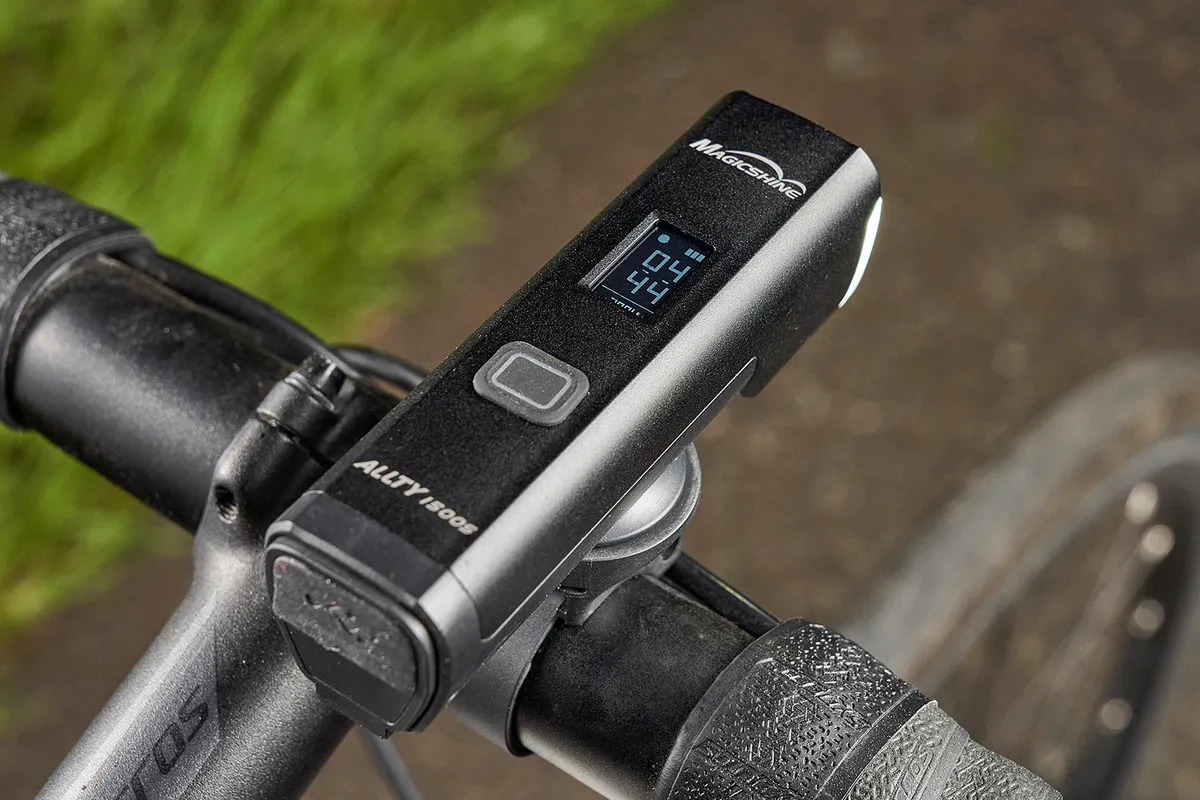
We test the battery life of all lights we review, running them on their maximum power output to see how long they last.
Bike lights have different modes and typically run through the battery quickest in the maximum power output mode. That means the runtimes quoted in this list will likely be the minimum time a light’s battery will last.
You may need the highest power output when riding off-road, where there are more obstacles. But a lower power mode will often be sufficient and your eyes will adjust to the dimmer light level.
Flashing lights will give you the longest battery life and are ideal for visibility, particularly when riding in the daytime.
Some lights will reduce their output as the battery begins to run down to extend battery life.
Many of the best cycling lights for road riding and commuting will have internal batteries that you charge via a cable or in-built USB connector.
A greater runtime will typically mean a larger battery and therefore a larger light. If you’re using lights for commuting, you may want a smaller light to stuff into your bag, but you may have to charge it more often.
A light with a longer battery life will be essential if you ride on unlit roads or go on long rides at night.
How to attach bike lights
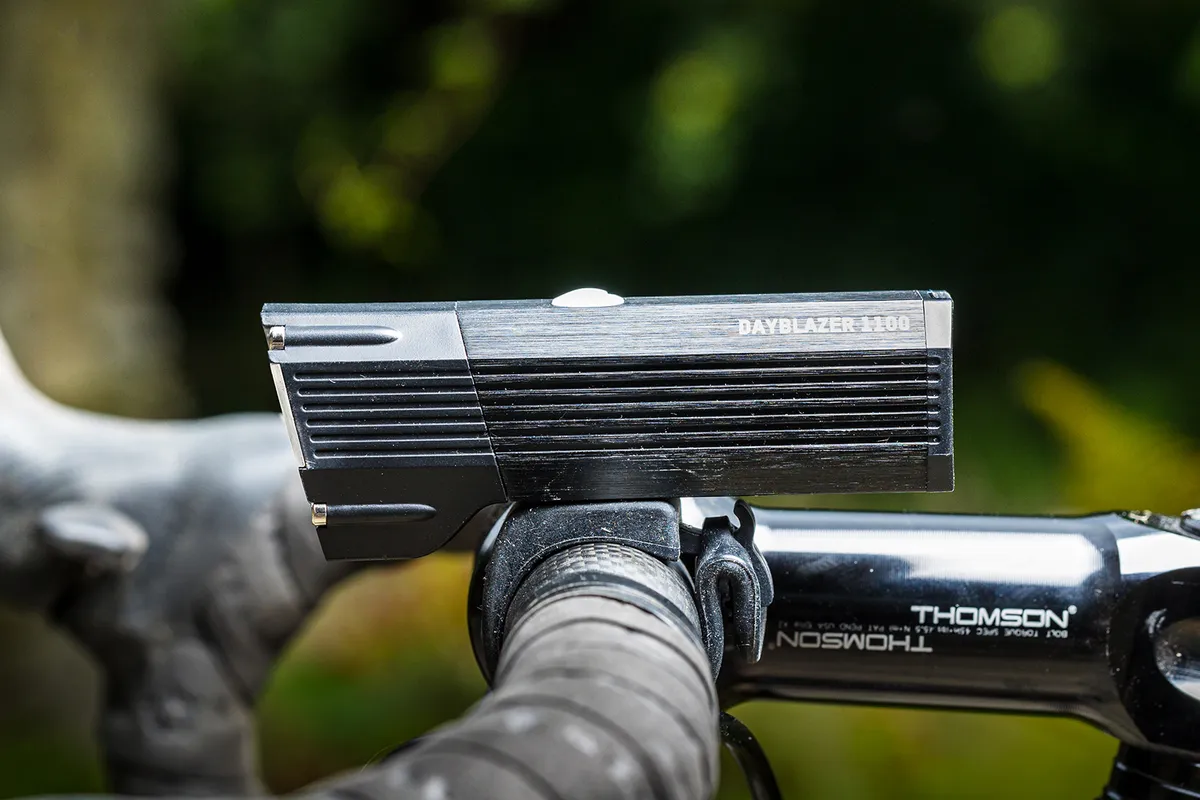
Bike lights typically attach to your bike with band or solid mounts.
Band mounts, made from rubber or silicone, are typically used on smaller bike lights. These bands loop around your handlebar or seatposts. They are quick and easy to attach to your bike or remove. The downside is they can move when you ride over rough ground.
Larger lights typically use solid plastic or metal mounting systems, which clip onto your bike or are secured with bolts. These are much more secure than band mounts but can be fiddly.
Whichever mounting option you choose, your bike lights should be visible to other road users and your front light illuminates the road.
Bike light laws
What does UK law say about bike lights?
According to the Road Vehicles Lighting Regulations, it’s a legal requirement in the United Kingdom to have lights on your bike and pedal and rear reflectors after sunset.
The lights must be mounted up to 150cm off the ground and be facing forward or rearward.
Front and rear lights can be flashing but must emit a minimum of 4 candelas, another light intensity unit. A candela is roughly equivalent to 12 lumens, so you can rest assured modern bike lights will comfortably exceed the minimum.
What does US law say about bike lights?
US bike light laws vary state by state. But typically you must have the following between sunset and sunrise or in low light conditions:
- A white front headlight is visible from a minimum of 500 feet away
- A red rear reflector visible from a minimum of 600 feet away
Some states also require side reflectors.
Beam pattern
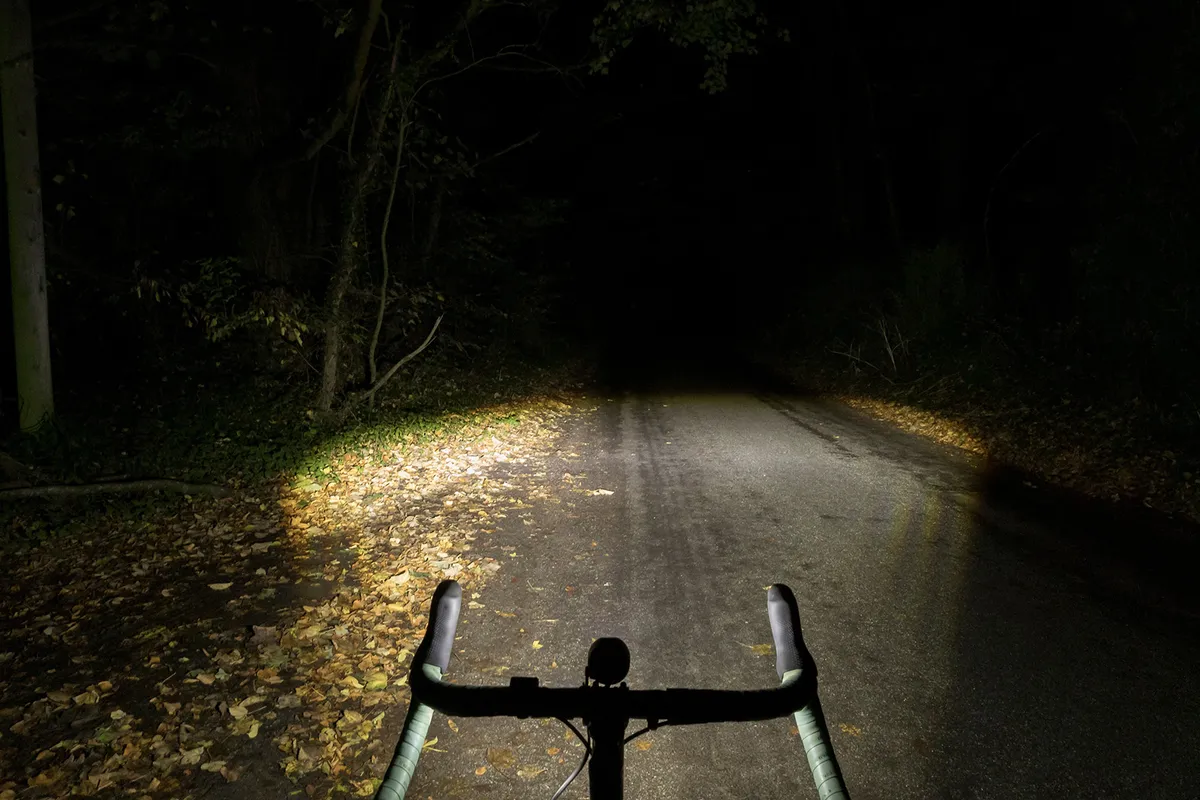
Beam pattern is arguably more important than brightness for seeing and being seen on the road.
Many of the best cycling lights will have reflectors or lens elements that alter the distribution of the light, so it’s either focused, wide or a combination of both.
A highly focused beam will emit light over a long range. This is good for lighting the road in font of you and fast riding, where you need to see further up the road.
A wider beam pattern is a good choice for country roads and seeing the side of the road. Wide beam patterns will make it easier for other road users to see you from a greater angle.
What about dynamo bike lights?

Dynamo bike lights rely on the power of a generator hub built into the front wheel, which turns rotational energy into electricity.
These lights are common on bike-share bikes and popular on town and touring bikes because they will never run out of charge.
Dynamo-powered headlights can emit over 700 lumens which is more than enough power for cycling at night on urban or unlit roads.
Most dynamo lights will have a capacitor or small battery to stay illuminated after you stop.
The downside to dynamo lights is that they can be expensive and complicated to set up. But if you want to never worry about charging, then it’s worth considering dynamo lights.
StVZO bike lights
StVZO bike lights conform to German Road Traffic Licensing Regulations, with beam patterns shaped to avoid dazzling other road users.
You don't need to use StVZO-approved lights anywhere other than Germany, but an StVZO light could be a good idea if you ride solely on the road.
The narrow beam of StVZO lights might not suit mountain bikers or bikepackers cycling at night, but more StVZO light options are becoming available that let you change between high and low beams to get around this issue.
Smart bike lights
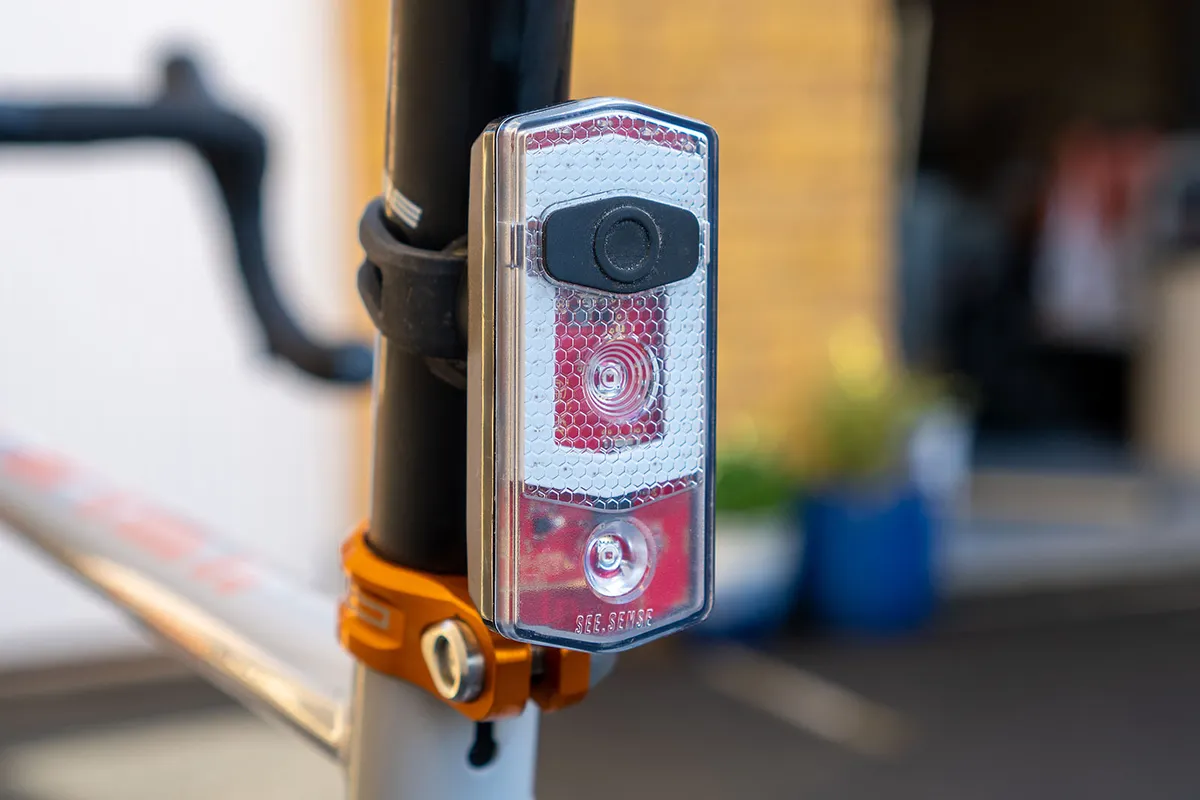
Smart bike lights pack intelligent features that will interact with other smart devices to act as motion-sensing warning systems or respond to what’s happening on the road.
The See.Sense Icon is one example of a smart bicycle light. The intelligent rear light will flash faster and brighter when drivers approach and at junctions. It will also send your smartphone a notification if someone tries to steal your bike.
Another example of a smart bike light is the Garmin Varia. The Varia will interact with your Garmin Edge bike computer to project light further ahead as your speed increases and, like the Icon, as drivers approach the rear light gets brighter.
Smart bike lights tend to be a pricier investment and require more effort to set up, but they’re worth considering if safety is your top priority.
Radar bike lights
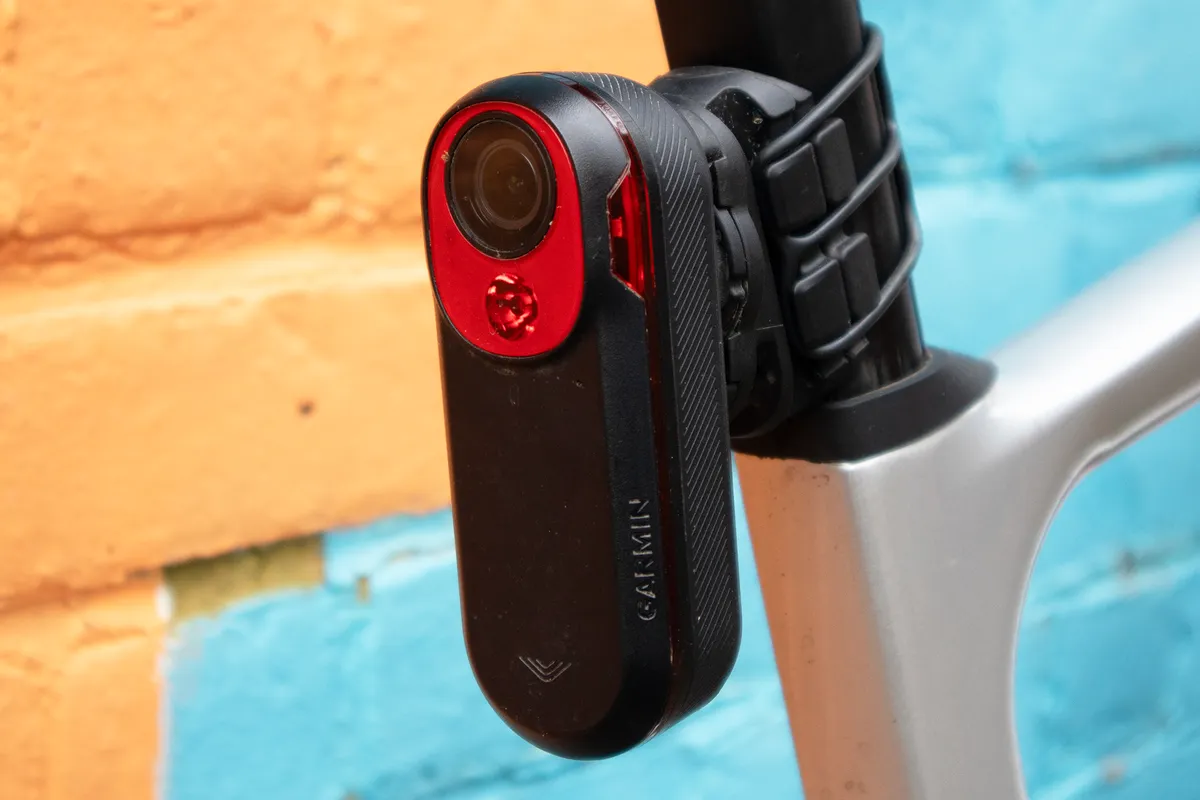
Rearview radar bike lights are smart lights that alert you to vehicles approaching from behind.
These lights emit a signal, which bounces off objects behind you before being collected and analysed by a detector to establish whether a vehicle is approaching you.
When a vehicle is detected, a radar bike light will send a signal to a connected smart device, such as a smartphone, cycling computer or smartwatch.
These lights can prove useful, especially when cycling in the daytime, where you won’t see a driver’s headlights – or when riding quickly, when wind noise can make it hard to detect a vehicle.
The Garmin Varia RCT715 is a radar bike light with an in-built camera that will save video clips if it detects an incident such as a crash.
Wahoo has also joined the party with its Trackr Radar, which also features an accelerometer that detects braking and ups the brightness and flashing of the light to alert other road users.
These systems aren’t faultless and you can’t assume that no alert means there’s nothing behind you.
Gravel bike lights

If you're looking for a set of the best cycling lights for gravel riding there are several things to consider.
A gravel bike light should be more powerful than a road bike light to illuminate unlit trails and gravel paths, but you probably won't need something as powerful as a mountain bike light.
We'd recommend a front light with a minimum of 600 lumens but you’ll probably want one with over 1,000 lumens. You may prefer a gravel bike light with more power than this if you prefer technical gravel riding and taking your bike down singletrack.
A rear light for gravel riding should also be powerful. Riding on dark roads will mean your rear light has to do more to keep you safe and seen.
More of the best bike lights
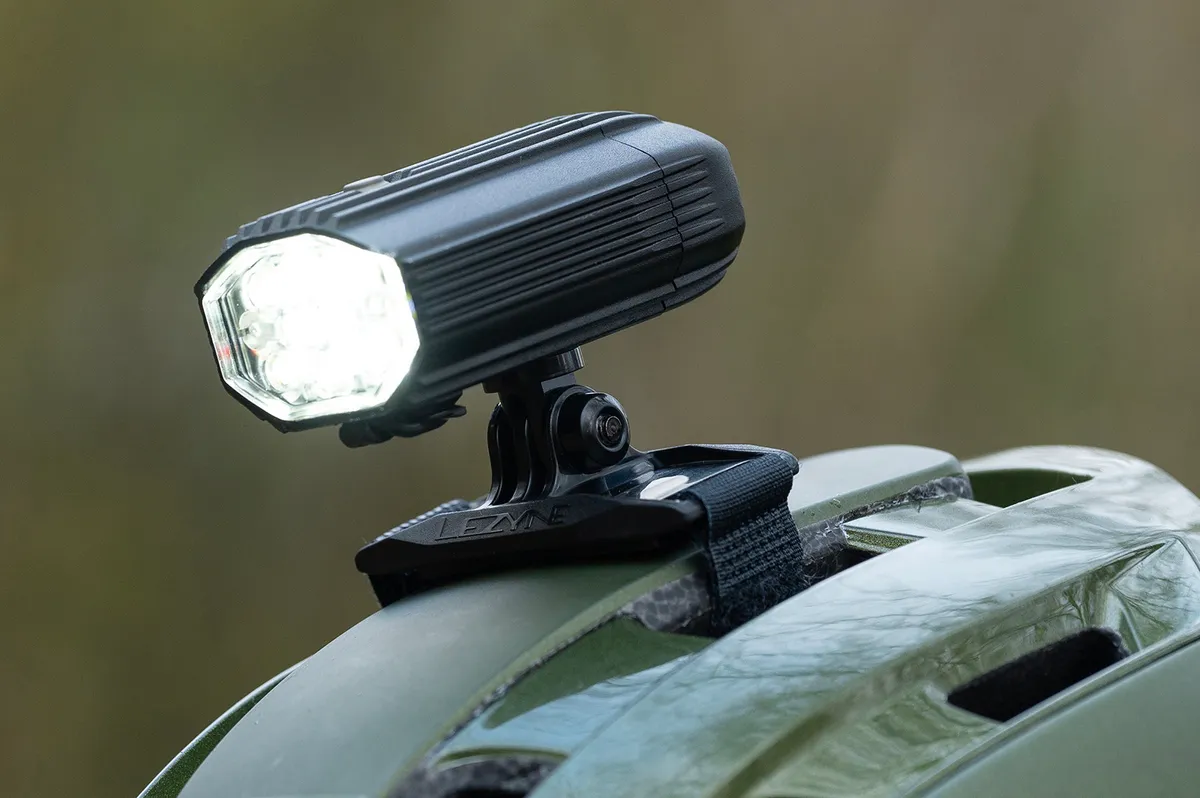
The lights in this list focus on road riding, but if you spend more time riding off-road, check out our pick of the best mountain bike lights.
Mountain bike lights typically have a wider beam pattern than road or commuting bike lights to illuminate more of the trail and often come with external battery packs.
If the lights in this list are over your budget, check out our pick of the best budget bike lights. These often compromise on battery life or power, but will still serve you well cycling to work.
